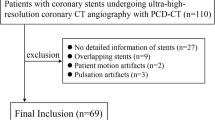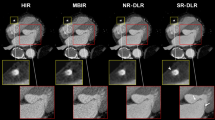Abstract
Objectives
To evaluate the effect of hybrid iterative reconstruction on qualitative and quantitative parameters at 256-slice cardiac CT.
Methods
Prospective cardiac CT images from 20 patients were analysed. Paired image sets were created using 3 reconstructions, i.e. filtered back projection (FBP) and moderate- and high-level iterative reconstructions. Quantitative parameters including CT-attenuation, noise, and contrast-to-noise ratio (CNR) were determined in both proximal- and distal coronary segments. Image quality was graded on a 4-point scale.
Results
Coronary CT attenuation values were similar for FBP, moderate- and high-level iterative reconstruction at 293 ± 74-, 290 ± 75-, and 283 ± 78 Hounsfield units (HU), respectively. CNR was significantly higher with moderate- and high-level iterative reconstructions (10.9 ± 3.5 and 18.4 ± 6.2, respectively) than FBP (8.2 ± 2.5) as was the visual grading of proximal vessels. Visualisation of distal vessels was better with high-level iterative reconstruction than FBP. The mean number of assessable segments among 289 segments was 245, 260, and 267 for FBP, moderate- and high-level iterative reconstruction, respectively; the difference between FBP and high-level iterative reconstruction was significant. Interobserver agreement was significantly higher for moderate- and high-level iterative reconstruction than FBP.
Conclusions
Cardiac CT using hybrid iterative reconstruction yields higher CNR and better image quality than FBP.
Key Points
• Cardiac CT helps clinicians to assess patients with coronary artery disease
• Hybrid iterative reconstruction provides improved cardiac CT image quality
• Hybrid iterative reconstruction improves the number of assessable coronary segments
• Hybrid iterative reconstruction improves interobserver agreement on cardiac CT


Similar content being viewed by others
References
Raff GL, Gallagher MJ, O’Neill WW, Goldstein JA (2005) Diagnostic accuracy of noninvasive coronary angiography using 64-slice spiral computed tomography. J Am Coll Cardiol 46:552–557
Budoff MJ, Achenbach S, Blumenthal RS et al (2006) Assessment of coronary artery disease by cardiac computed tomography: a scientific statement from the American Heart Association Committee on Cardiovascular Imaging and Intervention, Council on Cardiovascular Radiology and Intervention, and Committee on Cardiac Imaging, Council on Clinical Cardiology. Circulation 114:1761–1791
Hausleiter J, Meyer T, Hadamitzky M et al (2006) Radiation dose estimates from cardiac multislice computed tomography in daily practice: impact of different scanning protocols on effective dose estimates. Circulation 113:1305–1310
Mollet NR, Cademartiri F, van Mieghem CA et al (2005) High-resolution spiral computed tomography coronary angiography in patients referred for diagnostic conventional coronary angiography. Circulation 112:2318–2323
Alkadhi H, Leschka S (2011) Radiation dose of cardiac computed tomography—what has been achieved and what needs to be done. Eur Radiol 21:505–509
Klass O, Jeltsch M, Feuerlein S et al (2009) Prospectively gated axial CT coronary angiography: preliminary experiences with a novel low-dose technique. Eur Radiol 19:829–836
Klass O, Walker M, Siebach A et al (2010) Prospectively gated axial CT coronary angiography: comparison of image quality and effective radiation dose between 64- and 256-slice CT. Eur Radiol 20:1124–1131
Gutstein A, Wolak A, Lee C et al (2008) Predicting success of prospective and retrospective gating with dual-source coronary computed tomography angiography: development of selection criteria and initial experience. J Cardiovasc Comput Tomogr 2:81–90
Rybicki FJ, Otero HJ, Steigner ML et al (2008) Initial evaluation of coronary images from 320-detector row computed tomography. Int J Cardiovasc Imaging 24:535–546
Hirai N, Horiguchi J, Fujioka C et al (2008) Prospective versus retrospective ECG-gated 64-detector coronary CT angiography: assessment of image quality, stenosis, and radiation dose. Radiology 248:424–430
Shuman WP, Branch KR, May JM et al (2008) Prospective versus retrospective ECG gating for 64-detector CT of the coronary arteries: comparison of image quality and patient radiation dose. Radiology 248:431–437
Weigold WG, Olszewski ME, Walker MJ (2009) Low-doseprospectively gated 256-slice coronary computed tomographic angiography. Int J Cardiovasc Imaging 25:217–230
Leipsic J, Labounty TM, Heilbron B et al (2010) Estimated radiation dose reduction using adaptive statistical iterative reconstruction in coronary CT angiography: the ERASIR study. AJR Am J Roentgenol 195:655–660
Leipsic J, Labounty TM, Heilbron B et al (2010) Adaptive statistical iterative reconstruction: assessment of image noise and image quality in coronary CT angiography. AJR Am J Roentgenol 195:649–654
Fleischmann D, Boas FE (2011) Computed tomography–old ideas and new technology. Eur Radiol 21:510–517
Moscariello A, Takx RA, Schoepf UJ et al (2011) Coronary CT angiography: image quality, diagnostic accuracy, and potential for radiation dose reduction using a novel iterative image reconstruction technique-comparison with traditional filtered back projection. Eur Radiol 21:2130–2138
Leipsic J, Nguyen G, Brown J, Sin D, Mayo JR (2010) A prospective evaluation of dose reduction and image quality in chest CT using adaptive statistical iterative reconstruction. AJR Am J Roentgenol 195:1095–1099
Marin D, Nelson RC, Schindera ST et al (2010) Low-tube-voltage, high-tube-current multidetector abdominal CT: improved image quality and decreased radiation dose with adaptive statistical iterative reconstruction algorithm–initial clinical experience. Radiology 254:145–153
Taylor AJ, Cerqueira M, Hodgson JM et al (2010) ACCF/SCCT/ACR/AHA/ASE/ASNC/NASCI/SCAI/SCMR 2010 appropriate use criteria for cardiac computed tomography. A report of the American College of Cardiology Foundation Appropriate Use Criteria Task Force, the Society of Cardiovascular Computed Tomography, the American College of Radiology, the American Heart Association, the American Society of Echocardiography, the American Society of Nuclear Cardiology, the North American Society for Cardiovascular Imaging, the Society for Cardiovascular Angiography and Interventions, and the Society for Cardiovascular Magnetic Resonance. J Am Coll Cardiol 56:1864–1894
Jessen KA, Shrimpton PC, Geleijns J, Panzer W, Tosi G (1999) Dosimetry for optimisation of patient protection in computed tomography. Appl Radiat Isot 50:165–172
Raff GL, Abidov A, Achenbach S et al (2009) SCCT guidelines for the interpretation and reporting of coronary computed tomographic angiography. J Cardiovasc Comput Tomogr 3:122–136
Bittencourt MS, Schmidt B, Seltmann M et al (2011) Iterative reconstruction in image space (IRIS) in cardiac computed tomography: initial experience. Int J Cardiovasc Imaging 27:1081–1087
Wang G, Yu H, De Man B (2008) An outlook on x-ray CT research and development. Med Phys 35:1051–1064
Funama Y, Taguchi K, Utsunomiya D et al (2011) Combination of a Low-Tube-Voltage Technique With Hybrid Iterative Reconstruction (iDose) Algorithm at Coronary Computed Tomographic Angiography. J Comput Assist Tomogr 35:480–485
Funama Y, Awai K, Liu D et al (2009) Detection of nodules showing ground-glass opacity in the lungs at low-dose multidetector computed tomography: phantom and clinical study. J Comput Assist Tomogr 33:49–53
Oda S, Utsunomiya D, Funama Y et al (2011) A Low Tube Voltage Technique Reduces the Radiation Dose at Retrospective ECG-gated Cardiac Computed Tomography for Anatomical and Functional Analyses. Acad Radiol 18:991–999
Utsunomiya D, Oda S, Funama Y et al (2010) Comparison of standard- and low-tube voltage MDCT angiography in patients with peripheral arterial disease. Eur Radiol 20:2758–2765
Acknowledgement
We thank Mani Vember (Clinical Science—Computed Tomography Division, Philips Healthcare) for valuable technical comments.
Author information
Authors and Affiliations
Corresponding author
Rights and permissions
About this article
Cite this article
Utsunomiya, D., Weigold, W.G., Weissman, G. et al. Effect of hybrid iterative reconstruction technique on quantitative and qualitative image analysis at 256-slice prospective gating cardiac CT. Eur Radiol 22, 1287–1294 (2012). https://doi.org/10.1007/s00330-011-2361-6
Received:
Revised:
Accepted:
Published:
Issue Date:
DOI: https://doi.org/10.1007/s00330-011-2361-6




